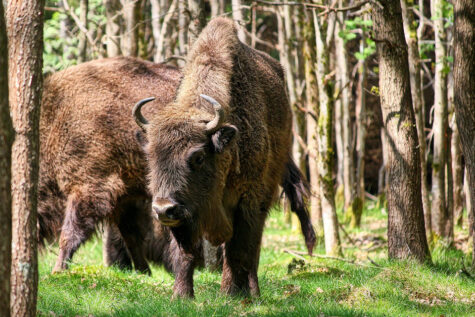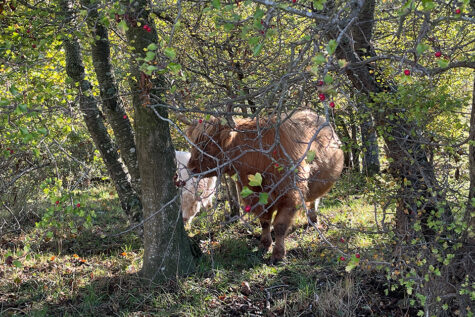Rewilding can’t alleviate all the climate challenges we face. Nevertheless, it does offer a precious contribution, namely a decisive upgrade of carbon sequestration in forests, grassland and tundras. With biodiversity as an added bonus.

In 2050 the world is expected to be carbon neutral. However, this technical effort is insufficient to keep temperatures from overstepping 1.5 °C. We also need to find ways to sequester vast amounts of the carbon emitted in the last 250 years. Hence, the UN also calls for removing an additional 500-1000 Gt of atmospheric CO2 already let loose and storing it on the planet between now and 2100 (equivalent to 7-14 Gt CO2 per year). To put this in perspective, the world’s forests already sequester 7.6 Gt per year. The need and obligation to enhance our current level of sequestration mean that we might have to double up the capacity of our forests.
One way to achieve this goal is by doubling the area of forests, meadows and extensive grasslands as of now! Another is to “animate the carbon cycle” and harvest an additional sequestration of an average of 6.5 Gt C worldwide.
While turning carbon neutral takes time and costs CO2 on the way when building windmill parks or nuclear installations, the beauty of the forest solution is that it might be orchestrated overnight. We just have to stop using considerable tracts to grow feed for animals and instead rewild them. Simply put, we may just set the action in motion by planting mixed forests, reclaiming the waterways, and letting large herbivores loose.
The Case for EU
In the EU, one opportunity is offered by the widespread agricultural abandonment suffered on marginal lands and a proposed shift towards wildlife ranching. In the EU 2020, 40 % of the total land is actively managed by farmers. To this should be added 15%, which is already either not worked or entirely abandoned. Furthermore, an additional 3 % of the total agricultural land in the EU is projected to be abandoned before 2030, adding 10 to 20 mill ha to this pool. As much of this land is farmed to feed animals, the only consequence will be the need to shift the European diet from north to south towards a more wholesome Mediterranean version (more vegetables and less meat).
Rewilding Mediterranean Rangelands
Much of this abandoned farmland lies in Southern and Eastern Europe (with Spain expected to suffer the most due to climate changes and desertification).
Although large wild herbivores and carnivores were traditionally abundant in the Mediterranean landscapes, the Roman Empire led to a near-complete extermination opening up for domesticated livestock to fill the niche in most of Western Europe. Until the dissolution of the fascist regimes in Spain and Portugal, these more traditional agricultural systems continued to favour extensive forms of pastoral production, including the care for extensive and semi-feral livestock, such as the large flocks of wild horses in Galicia and Northern Portugal, which used to roam there. Also, transhumance had a role to play in terms of biodiversity, disseminating seeds across vast stretches of land and regions . However, after entering the EU, large-scale industrialised farming was furthered, leading to the abandonment of more marginal lands, thus emptying the landscapes of animals and people. One consequence has been the more widespread and intense wildfires releasing copious amounts of carbon as well as causing severe losses of human lives and property.
What is needed?
- A courageous new policy adopting an active trophic rewilding policy
- A new ethos regarding nature conservation – from protection to ecosystem restoration
- An increased supply of animals – the need to develop ambitious and international breeding programmes of “pools” of wild animals stemming from free-range flocks
- Reorientation of subsidies from production to ecosystem restoration
The Return of the Ice Age?
One of the questions raised by the rewilding movement is whether this paradigm implies a return to long-bygone landscapes or whether the project is future-oriented. Without a doubt, the latter is the case as rewilding foremost works to reconstitute and reconstruct robust self-regulating ecosystems where nature and the remains of our threatened biodiversity may once more flourish.
However, the question is not mute. We shall never return to any world that was. Nevertheless, we may still use history to inspire us to imagine what kind of landscapes we might encounter in the future, if rewilding became a dominant and preferred paradigm – as should be the case because of its climatic advantages. Might it be a version of the Pleistocene landscape before, during, and immediately after the Last Ice Age? Or – as is it more likely – might a version of the Early Medieval Landscape be the next vision forEuropean Nature?
To ponder this question, we must explore some aspects of what took place in nature and landscape during and after the Roman Empire.
A Return of the Early Medieval Landscape?
“There is a third kind, consisting of animals called URI. These are a little below the elephant’s in size and have the appearance, colour, and shape of a bull. Their strength and speed are extraordinary; they spare neither man nor wild beast which they have espied. With much effort, the Germans hound them into pits and kill them. The young men harden themselves with this exercise and practice this kind of hunting. Those who have slain the greatest number of them and can produce their horns publicly to serve as evidence receive great praise. But not even when taken very young can the animals be rendered familiar to men and tamed. The size, shape, and appearance of their horns differ much from the horns of our oxen. These they anxiously seek after, to bind the tips with silver that they may be used as cups at their most sumptuous entertainments. ”
(Caesar De Bello Gallico, chapter XXVIII)

The period of megafauna was undoubtedly the Pleistocene, which ended 11.700 years ago. It included aurochs, wild boars, giant deer, elephants and massive predators. This assembly of animals roamed the Mediterranean when food for herbivorous animals was widely available in the forests along coastlines and rivers whose estuaries, marshes and lagoons would serve as grazing for these large animals. Although extinction began long before the Roman Empire flourished, the Mediterranean forests’ destruction followed in the Roman Army’s footsteps with its insatiable need for energy, metal, building resources, timber for shipbuilding, animals for entertainment and leather for shoes. In this connection, hides from the “Urus” – the auroch – were especially sought after. Thus, a riot broke out among the Frisians, who were obliged to pay their taxes in hides, when the Roman governor in AD 28 suddenly demanded hides from aurochses. The Frisians, who could not meet these demands, suffered forced requisitions of cattle, confiscations of land and enslavement of the families of defaulters, which eventually led to rebellion an mass slaughter.
Thus, judging by Caesar, the Romans not only demanded their hides as tribute, they also tried to domesticate the aurochses. And even though Caesar denied the feasibility, we may judge by the size of Roman cattle that they probably succeeded again and again in mingling domesticated cattle with the grand wild beasts roaming the ancient landscape.
However, these breeding programs fell apart after the Fall of the Roman Empire, leaving the Early Medieval People in a wilder landscape with their small and insignificant animals. At the same time, the diminished flocks of aurochses retreated to the peripheries of Eastern Europe to become extinct as a distinct wild variety in the 16th – 18th century. We do know, however, that more or less semi-feral cattle and horses continued to roam the landscapes. (Hence, it never involved much ingenuity to back breed a passable version of the aurochs as part of the so-called Taurus Project).
To sum up, most European peasants in the Early Middle Ages moved through a vastly different and much more animated landscape than ours, in which wild horses and aurochses mingled freely with semi-feral flocks of cattle and horses. Once again, Europe was home to a much more extensive pastoral economy. Granted, the large areas of the loess landscape in present-day Eastern France and Western Germany continued to be farmed intensively. Incidentally, this landscape became the core of the Carolingian world and the recreation of the West Roman Empire in 800, when Charlemagne was crowned in Rome. However, the traditional pre-Roman agricultural system was once again dominant on the peripheries.
How should we imagine this landscape? At its core was one or more independent semi-pastoral peasant holdings consisting of intensively cultivated fields near the farm, surrounded by more or less extensively used pastoral grounds – meadows, grazing forests and more remote wildernesses. We know, this landscape came about in the sixth century following tumultuous climatic and political upheavals, widespread cooling in the north and the devastation caused by the Justinian plague. And we know the next four to five hundred years gave the European nature and landscape a much-needed breathing space following the intense overexploitation caused by the Roman Imperial army and administration.
Perhaps, we might be inspired by these events?
Karen Schousboe
SELECTED SOURCES
Abandoned Farmland: Past Failures or future opportunities for Europe’s Green Deal? A Baltic case-study
By Kristine Valujeva, Mariana Debernardini, Elizabeth K. Freed, Aleksejs Nipers, and Rogier P.O. Schulte
In: Environmental Science & Policy (2022) Vol 128, pp 175-184
Addressing challenges for large-scale trophic rewilding
By Deli Saavedra, Néstor Fernández, and Jens-Christian Svenning
In: Journal for Nature Conservation (2023) Vol 73, 26382, p. 2)
Animating the Carbon Cycle: How Wildlife Conservation Can Be a Key to Mitigate Climate Change
Oswald J. Schmitz and Magnus Sylvén
In: Environment: Science and Policy for Sustainable Development (2023) Vol 65, No 3, pp 5-17
Dynamics of rural landscapes in Marginal Areas of Northern Spain: Past, Present, and Future
José Antonio González Díaz, Rafael Celaya, Felipe Fernández García, Koldo Osoro, Rocío Rosa García
In: Land Degradation and Development.
(2019) Volume 30, Issue2, pp. 141-150
Grasslands and scrublands in the northwest of the Iberian Peninsula: Silvopastoral systems and nature conservation
By Fransisco Javier Silva-Pando, Maria José Rozados Lorenzo & María Pilar González Hernández
In: Pasture Landscapes and Nature Conservation. By Bernd Redecker, Werner Härdtle, Peter Finck, Uwe Riecken, Eckhard Schröder
Springer Verlag 2002
Intergovernmental Panel on Climate Change (IPCC), Climate Change 2022: Mitigation of Climate Change. Contribution of Working Group III to the Sixth Assessment Report of the Intergovernmental Panel on Climate Change
Ed. by P. R. Shukla et al.
Cambridge University Press, 2022.
New Perspectives on the Medieval ‘Agricultural Revolution’. Crop, Stock and Furrow.
By Helena Hamerow and Mark McKerracher
Liverpool University Press 2022
Open Access
Trade-offs between passive and trophic rewilding for biodiversity and ecosystem functioning
By Andrew J. Tanentzap a, Georgia Daykin a 1, Thea Fennell a 1, Ella Hearne a 1, Matthew Wilkinson b, Peter D. Carey a, Ben A. Woodcock c, Matthew
In: Biological Conservation (2023) Vol 281